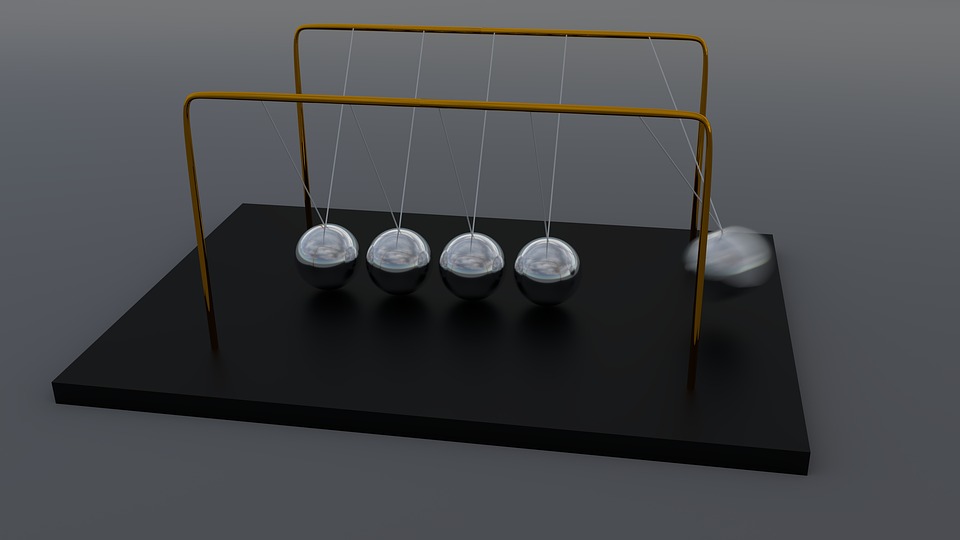Physics is one of the most fundamental scientific disciplines, and its main goal is to understand and explain how things are working all around us. It is a science of reality, certainty, demonstration, fascination and repeatability and sometimes, can be used to create beautiful art. Waves and harmonic motion (some examples include pendulums and springs) are often great sources of inspiration for creating mesmerizing displays. Role of simple pendulum in the study of physics has its special place from the time of Galileo Galilei to present school laboratories. Pendulum is a point mass (metallic bob) attached to a string suspended from a rigid support. Pendulum Effect is the movement in one direction that causes an equal movement in another direction. Moreover, it describes the continuous swinging motion of pendulum that is created by the acquired momentum and the action of gravity.
Pendulums have been around for thousands of years and the ancient Chinese used the pendulum principle to try and help predict earthquakes. Galileo Galilei was the first European to really study pendulums and he discovered that their regularity could be used for keeping time, leading to the first clocks. In 1656, the Dutch inventor and mathematician, Huygens, was the first man to successfully build an accurate clock. Sometimes just witnessing a physics demonstration can inspire students to look more deeply into conceptual nature of the demonstration and strengthen their critical thinking skills. The Pendulum Wave is a device that provides such an opportunity. It consists of a series of pendulum with increasing periods that when simultaneously released, produce the effect of a changing transverse wave that cycles back to the beginning conditions.
Pendulum wave effect
The uncoupled or coupled pendulums shown in the figure play one of the fascinating wave patterns and can be seen on internet from various videos (YouTube) available. The project uses the laws of simple pendulum motion to create a “pendulum wave apparatus”: a device where many pendulums of different lengths (and therefore different periods) start swinging at the same time. As they move in and out of sync, the pendulums create a sequence of cycling visual wave patterns. The effect works by using a formula that provides the specific length for each string. When all of the pendulums are started at once the patterns will start to form and the pattern resets after about 1 minute. A set of uncoupled simple pendulums of monotonically increasing lengths dance together to produce visual traveling waves, standing waves, beating, and (seemingly) random motion. The set of pendulums act like discreet samples of a sinusoid which gradually increases in frequency. It starts to look more and more 'random' until the frequency reaches the Nyquist Frequency - the wavelength equals two samples. At that point, 'aliasing' occurs: the frequency appears to decrease and go through the exact same process in reverse, until it reaches back to initial state of rest and all the pendulums are lined up again.
Working of Pendulum Wave system
This device shows a hypnotic effect by having a series of pendulums with increasing time periods so that when they are simultaneously released, they produce the effect of a wave. The wave in this case diminishes in wavelength, then looks very chaotic, and then comes back to the straight line from which it started. Pendulum length is an important parameter and the lengths of each pendulum are related to the one next to it in a way that after a certain number of swings, they are back in phase with each other. To calculate the lengths of the pendulums, start with the longest time period (T). Decide how many cycles of that pendulum you would want before all the pendulums are back in phase. To build the stand, calculate the difference in lengths for adjacent pendulums. Take the difference between adjacent pendulums, this will form the steps on the stand so the swinging bobs are at the same level. The method of attachment is up to the builder, but the string supporting each pendulum needs to be pinched to make a definite length. The bob support string is bifilar, or two stringed, one on each side of the bob. The top ends need to be separated by enough distance to assure stability. The ability to make fine adjustments to the length is necessary so the device can come back to line after two or even three cycles. The Large Pendulum Wave is a kinetic light art installation based on physical laws and there are no tricks involved. The Pendulum Wave is a physical phenomenon based on a number of independent pendulums that are very accurately adjusted concerning swinging period (or frequency). Each pendulum can swing independently from each other. Due to the different length of each pendulum the swinging frequency is different for each pendulum. Once the frequencies are very accurately adjusted according to a mathematical sequence, the pendulums produce a dance of standing and running waves and quasi chaos.
- 15 pendulums, each with a unique length
- The length of the longest pendulum has been adjusted so that it executes 51 oscillations in 60 seconds period.
- The length of each successive shorter pendulum is carefully adjusted so that it executes one additional oscillation in this period. Thus, the 15th pendulum (shortest) undergoes 65 oscillations.
- When all 15 pendulums are started together, they quickly fall out of sync-their relative phases continuously change because of their different periods of oscillations. However, after 60 seconds they will all have executed an integral number of oscillations and be back in sync again at that instant, ready to repeat the dance.
